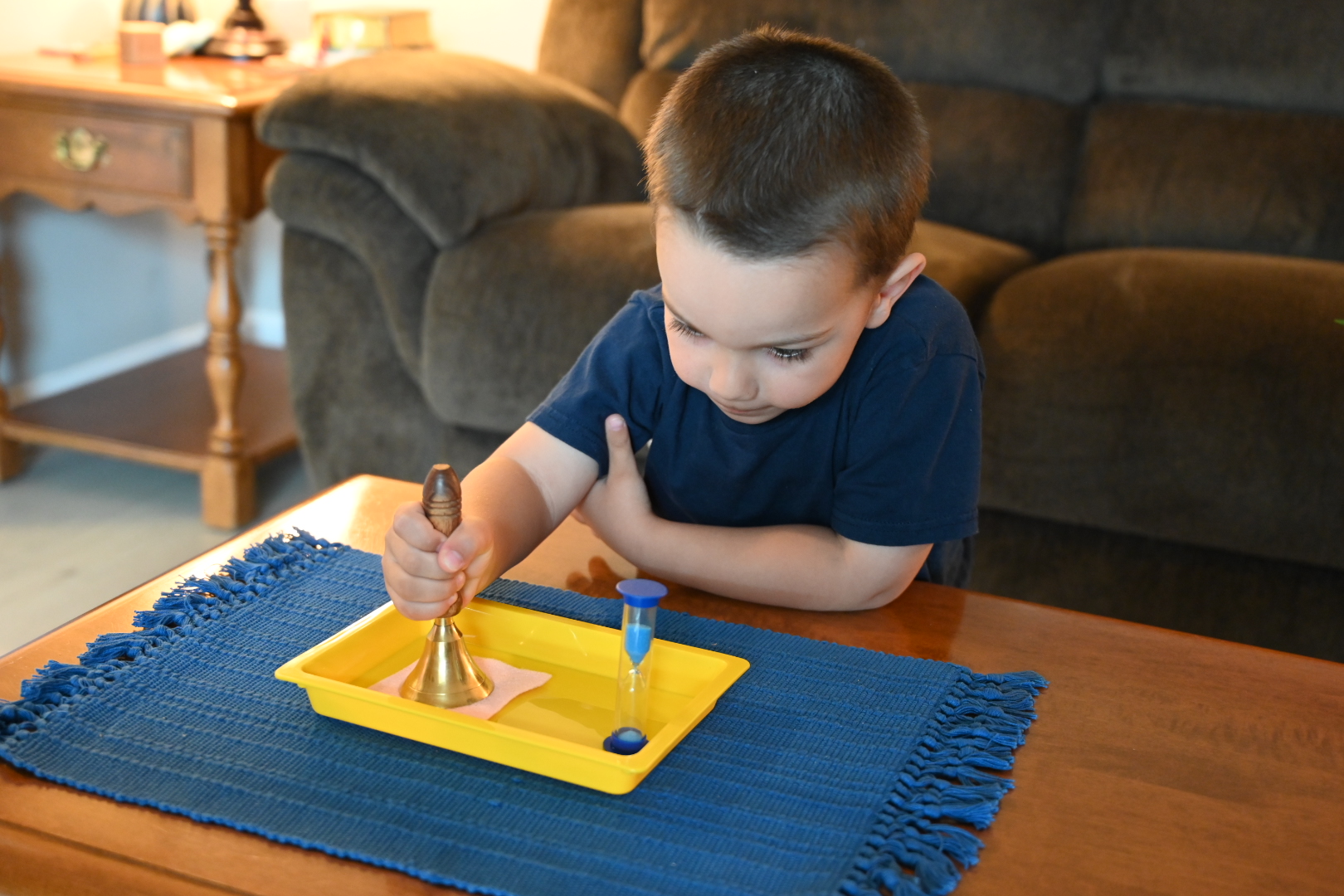The Silence Game
The Montessori silence game is the activity every parent dreams of. Why? It teaches children patience and manners all while getting a few moments of much-needed peace and quiet.
Traditionally, the Montessori silence game is played in a Montessori classroom with the entire class. Our adaption of the game will help you play this game even if you’re doing Montessori at home and your class has just one student.
The Montessori Silence Game at Home
What You’ll Need
- A bell
- A sand timer (Optional: many sand timers of varying lengths)
- A tray
How It Works
Like all Montessori activities, this activity starts with both preparing the materials and introducing the activity. Place the sand timer and bell on the tray. Then, present the activity to your child. Presenting activities the Montessori way starts with inviting your child to participate. Use as few words as possible, and focus on showing rather than telling.
The game starts as the child flips the sand timer over. As the sand falls (usually for 30 or 60 seconds, depending on your timer), the child should be completely quiet. Then, once the timer is up, the child picks up the bell and rings it. After they ring the bell, they’re free to make noise again! When I did this with my son, he was so excited to ring the bell that he jumped up and rang it with joy. He immediately asked to do it again. Success!
Increasing Difficulty
We’ve outlined the basics of our silence game above. However, there are a few adaptions that can continue to keep the game fresh and challenging!
There are many sand timer sets available online that include several timers of different lengths. To make this version of the silence game more challenging, place several sand timers on the tray. You can start with just two sand timers and work up to more depending on the child’s interest and skill level.
Instead of ringing the bell after just one timer runs out, the child rings the bell after each timer runs out. Depending on your timers, this may be after 30, 60, and 90 seconds. The child should stay silent until the final timer runs out. As they get more proficient, you can increase the time and use 3, 5, and even possibly a 10 minute timer!
The Benefits
 The silence game is excellent practice to help a child learn to be quiet when necessary. Since the child quietly waits for the timer to finish, this version of the silence game also encourages focus, patience, and concentration. Time is an abstract concept, but working with sand timers can make the concept more concrete and help children learn what different lengths of time feel like.
The silence game is excellent practice to help a child learn to be quiet when necessary. Since the child quietly waits for the timer to finish, this version of the silence game also encourages focus, patience, and concentration. Time is an abstract concept, but working with sand timers can make the concept more concrete and help children learn what different lengths of time feel like.
On a more spiritual level, Dr. Maria Montessori believed that silence was good for the soul. “As a beautiful environment with light, colour, perfume can have an influence on poetical inspiration,” she wrote, “so silence gives us above all the surprise of possessing within us something which we did not know we had, spirituality, and the little child tends to feel this interior life, because he is by excellence the interior being.”
Another benefit? The silence game is fun for children, too!
The History of the Montessori Silence Game
In a traditional Montessori silence game, a teacher very quietly whispers the name of each student. As their name is called, each student approaches the teacher as quietly as they can. The teacher is out of the children’s sight, either behind them or in a different room, to make sure the children aren’t reading her lips.
“This exercise and others bring little by little a discipline composed of calmness and interior beatitude,” Dr. Montessori wrote.
The history of the silence game began when Dr. Montessori, who worked with partially deaf children, quietly called the children’s names to test their hearing. She found that they not only heard their names but were also surprisingly patient in the process. She began playing the game with hearing children and found it greatly benefitted them as well.
In Dr. Montessori’s Own Handbook, she spoke about how the silence game helps children gradually learn to be more careful and intentional as they go about their day-to-day tasks.
“When the children have become acquainted with silence, their hearing is in a manner refined for the perception of sounds,” she wrote. “Those sounds which are too loud become gradually displeasing to the ear of one who has known the pleasure of silence, and has discovered the world of delicate sounds. From this point the children gradually go on to perfect themselves; they walk lightly, take care not to knock against the furniture, move their chairs without noise, and place things upon the table with great care.”
Once you’ve played this twist of the Montessori silence game, let us know in the comments or on social media. We’d love to hear how it goes!






I have used a version of this game in my child care business as well as with my own children. One version I love is when we are outside we quietly sit and watch the birds and squirrels and dragonflies and listen for their sounds and the sound of the breeze in the trees. There are also man made noises to notice. It is a lovely way to spend some time.